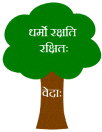Difference between revisions of "Template:Featured Articles"
| (6 intermediate revisions by the same user not shown) | |||
| Line 1: | Line 1: | ||
<!--Hooks--> | <!--Hooks--> | ||
<div class="dyk-img" style="float: right; margin-left: 0.5em;"> | <div class="dyk-img" style="float: right; margin-left: 0.5em;"> | ||
| − | {{main page image|image= | + | {{main page image|image=Dharmo_rakshati_rakshitah.png|width=120x133}} |
</div> | </div> | ||
| − | '''Vedas (वेदाः)''' | + | '''Vedas and Dharma (वेदाः धर्मः च)''' |
| − | The Vedas ( | + | [[The Four Vedas (चतुर्वेदाः)|Vedas]] (वेदाः) and Dharma (धर्मः) have been the pillars on which [[Sanatana Dharma (सनातनधर्मः)]] stood ground since time immemorial. That Vedas are the source of all Dharma (in moral, social, religious, judicial, and spiritual sense) is irrefutably advocated by all authoritative texts of our [[Bharatiya Samskrtika Parampara (भारतीयसांस्कृतिकपरम्परा)|Bharatiya Samskrtika Parampara]]. The word Dharma (धर्मः), for which no word of any language can be substituted, is used erroneously and loosely in the sense of sanctioning various unrighteous deeds in the name of changing society and times by different people all over the globe. [[Vedas and Dharma (वेदाः धर्मः च)|...View More]] |
| − | + | '''Related Links''' | |
| − | + | * [[Vedas (वेदाः)]] | |
| − | + | * [[Veda Vargeekarana (वेदवर्गीकरणम्)|Veda Vargeekarana (वेदवर्गीकरणम्)]] | |
| − | + | * [[Categories|Other Categories...]] | |
| − | * | ||
| − | + | '''Vaidika Vangmaya (वैदिकवाङ्मयम्)''' | |
| − | + | Vaidika Vangmaya (Samskrit : वैदिकवाङ्मयम्) means that literature which is "associated with the Vedas". Vaidika literature includes the ancillary and subsidiary texts associated with the Vedas which have come into existence to clarify and understand the Vedas. Thus over a period of time, different explanatory shastras evolved to explain the subtle concepts presented in Vedas and they are included in under the Smriti literature.The following headings cover the topics discussed under Vaidika Vangmaya | |
| − | + | ||
| − | + | # वेदाङ्गानि || [[Shad Vedangas (षड्वेदाङ्गानि)|Vedangas]] (6) | |
| − | + | # उपवेदाः || [[Upavedas (उपवेदाः)|Upa-Vedas]] (4) | |
| + | # वेद-उपाङ्गानि || Veda-Upangas (4) | ||
| + | ## पुराणानि || Puranas (18), उपपुराणानि || Upa-Puranas (18), इतिहासः || Itihasa (2) | ||
| + | ## दर्शनानि ॥ Darshana Shastras (6) | ||
| + | ## स्मृतिग्रन्थाः || Smrti Granthas or Dharmashastras (18) | ||
| + | # अन्यग्रन्थाः || Other Smrtigranthas (Anukramanikas, Pratisakhyas, Parishistas) [[Vaidika Vangmaya (वैदिकवाङ्मयम्)|...View More]] | ||
Latest revision as of 12:14, 2 November 2018
Vedas and Dharma (वेदाः धर्मः च)
Vedas (वेदाः) and Dharma (धर्मः) have been the pillars on which Sanatana Dharma (सनातनधर्मः) stood ground since time immemorial. That Vedas are the source of all Dharma (in moral, social, religious, judicial, and spiritual sense) is irrefutably advocated by all authoritative texts of our Bharatiya Samskrtika Parampara. The word Dharma (धर्मः), for which no word of any language can be substituted, is used erroneously and loosely in the sense of sanctioning various unrighteous deeds in the name of changing society and times by different people all over the globe. ...View More
Related Links
Vaidika Vangmaya (वैदिकवाङ्मयम्)
Vaidika Vangmaya (Samskrit : वैदिकवाङ्मयम्) means that literature which is "associated with the Vedas". Vaidika literature includes the ancillary and subsidiary texts associated with the Vedas which have come into existence to clarify and understand the Vedas. Thus over a period of time, different explanatory shastras evolved to explain the subtle concepts presented in Vedas and they are included in under the Smriti literature.The following headings cover the topics discussed under Vaidika Vangmaya
- वेदाङ्गानि || Vedangas (6)
- उपवेदाः || Upa-Vedas (4)
- वेद-उपाङ्गानि || Veda-Upangas (4)
- पुराणानि || Puranas (18), उपपुराणानि || Upa-Puranas (18), इतिहासः || Itihasa (2)
- दर्शनानि ॥ Darshana Shastras (6)
- स्मृतिग्रन्थाः || Smrti Granthas or Dharmashastras (18)
- अन्यग्रन्थाः || Other Smrtigranthas (Anukramanikas, Pratisakhyas, Parishistas) ...View More
